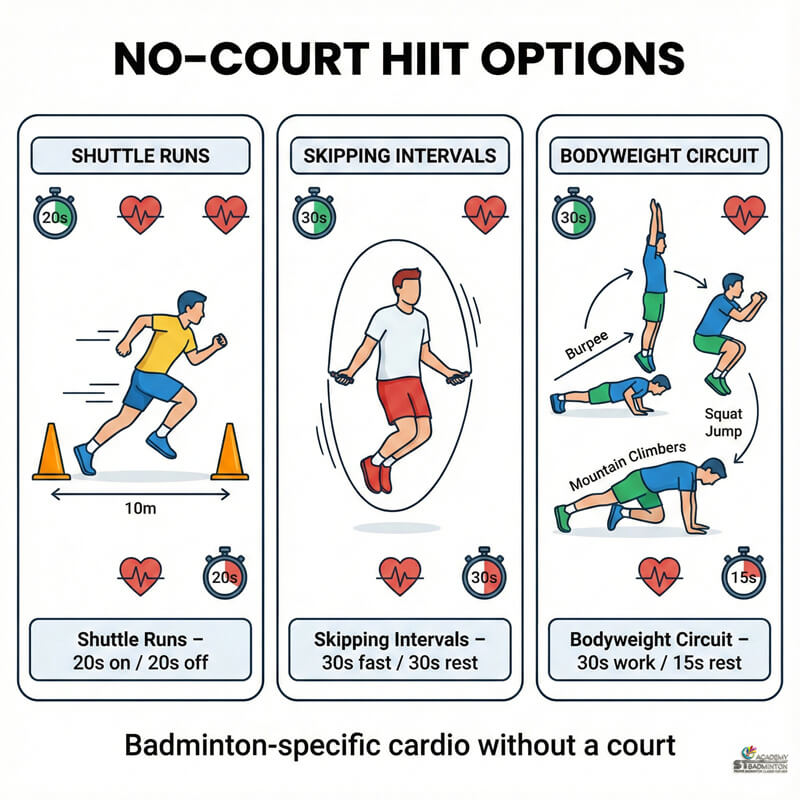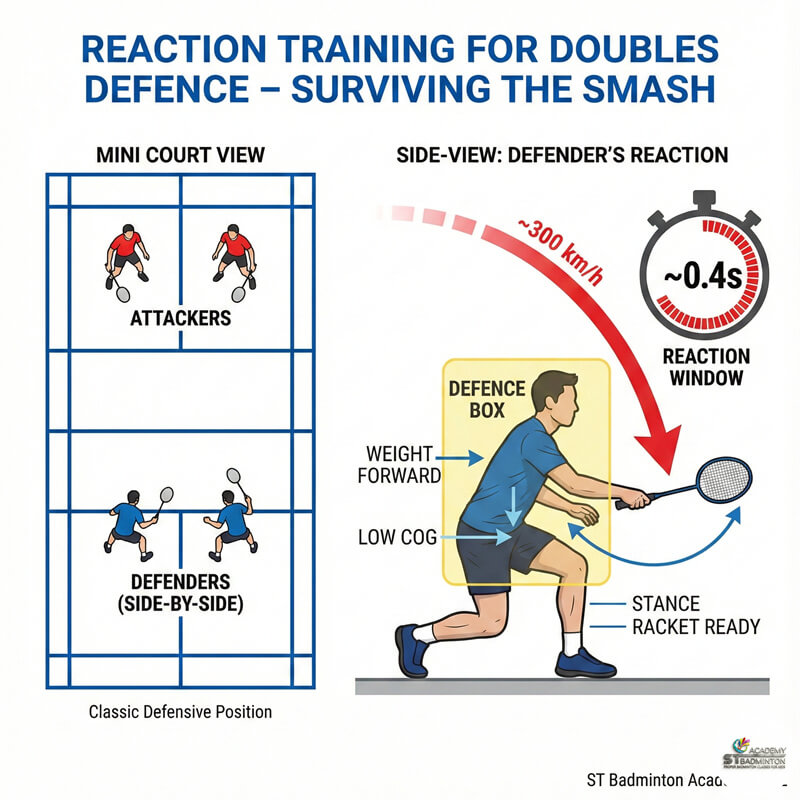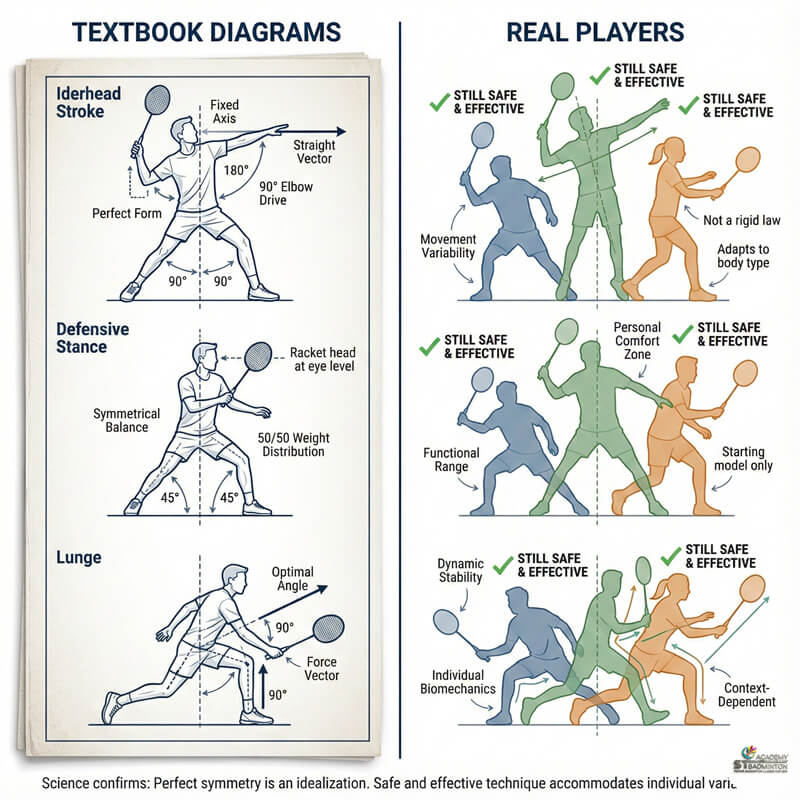The Importance Of Rest And Recovery In Badminton: Tips For Avoiding Burnout (Malaysia Guide)
For badminton players, understanding the importance of rest and recovery in badminton is just as critical as mastering a good smash. Without enough rest, your muscles, joints, and nervous system cannot repair and adapt, leading to weaker performance and a higher risk of injury. Burnout in badminton is a state of physical and mental tiredness, causing a loss of motivation, more frequent injuries, and a drop in on court results. This guide is for young players, school team members, serious adults, and parents in Kuala Lumpur, Selayang, Kepong, Air Panas and nearby areas. While good rest habits can significantly reduce injury risk and support long term progress, they are not a substitute for proper coaching or professional medical care when you have pain.
A badminton coach explains why rest and recovery matter and shares simple tips to avoid burnout for players in Kuala Lumpur.
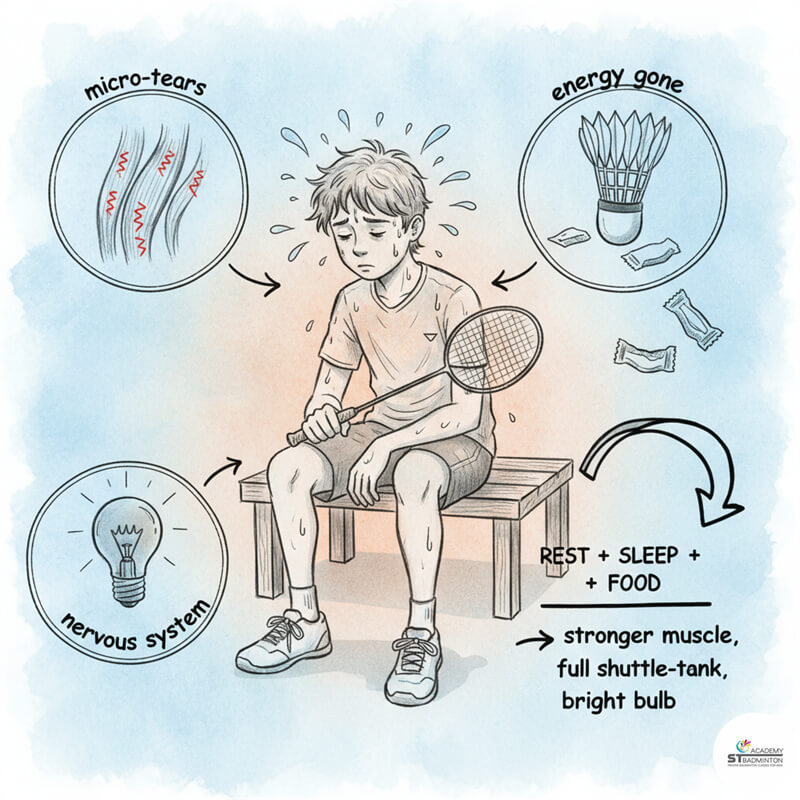
The Science of Training
What Happens To Your Body After Badminton Training?
Badminton is a high intensity sport with lots of jumping, lunging, and powerful swings. This places significant stress on the body. After a tough training session, your body isn’t immediately stronger, it’s actually weaker. The magic happens during recovery. Here’s a simple breakdown of what’s going on inside your body:
First, your muscles get tiny micro tears during exercise. Rest, along with protein from food, is needed to repair these tears, making the muscles stronger than before. Second, your body’s main fuel source, called glycogen, gets used up. It takes time and proper food intake to refill these energy stores for your next session. Finally, your nervous system, which controls all those fast decisions and explosive movements, gets tired. Joints in your knees, ankles, and shoulders also need a break from high impact movements.
This is why smart coaches in Kuala Lumpur always build planned rest into a training schedule. The real improvements in strength and skill happen when the body is allowed to heal and adapt. Constant training without proper badminton rest and recovery leads to a plateau in performance and, eventually, burnout or injury.
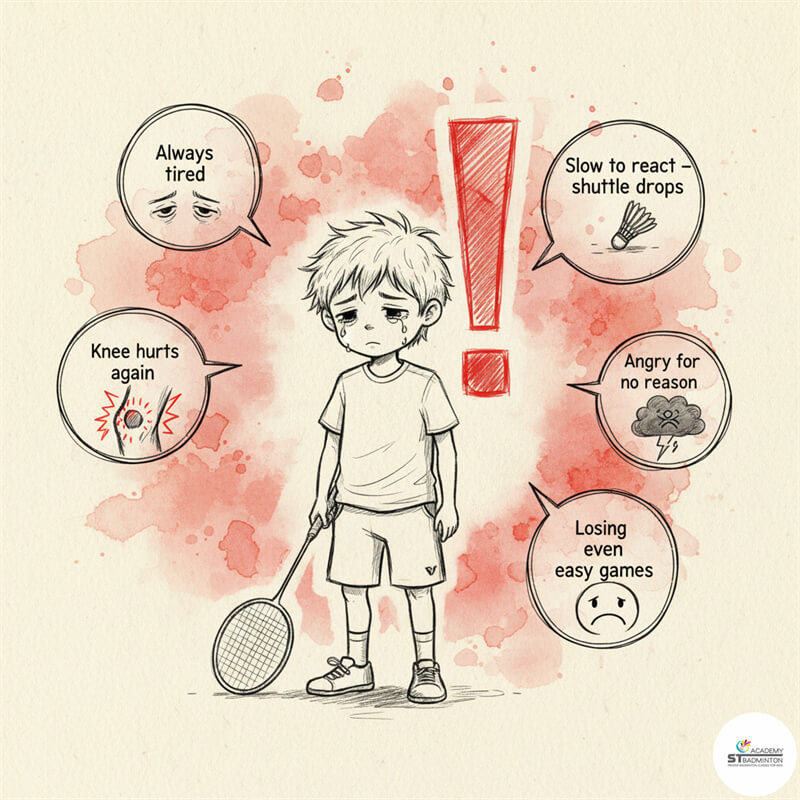
Warning Signs
Common Signs of Overtraining and Badminton Burnout
It’s important for parents and players to recognise the difference between normal tiredness from a good workout and the warning signs of overtraining and burnout. Ignoring these signs can lead to long term injuries and a loss of love for the sport. Many parents want to know how to avoid badminton burnout while ensuring their kids improve.
Here are some common signs to watch for, especially in young players:
- Feeling tired all the time, even after an easy session or a full night’s sleep.
- Making more mistakes than usual and reacting slower on court.
- Frequent small injuries or nagging pains in the knees, ankles, wrist, or shoulder that don’t seem to go away.
- Mood changes, like getting frustrated easily, feeling down, or not looking forward to training anymore.
- A drop in match performance, even when training more than ever.
For example, a school player from Kepong or Selayang who trains four nights a week and rushes from school to tuition to the court with no break is at high risk. They might start complaining about small pains or seem less energetic. This isn’t a sign of weakness; it’s the body’s way of saying it needs more recovery time.
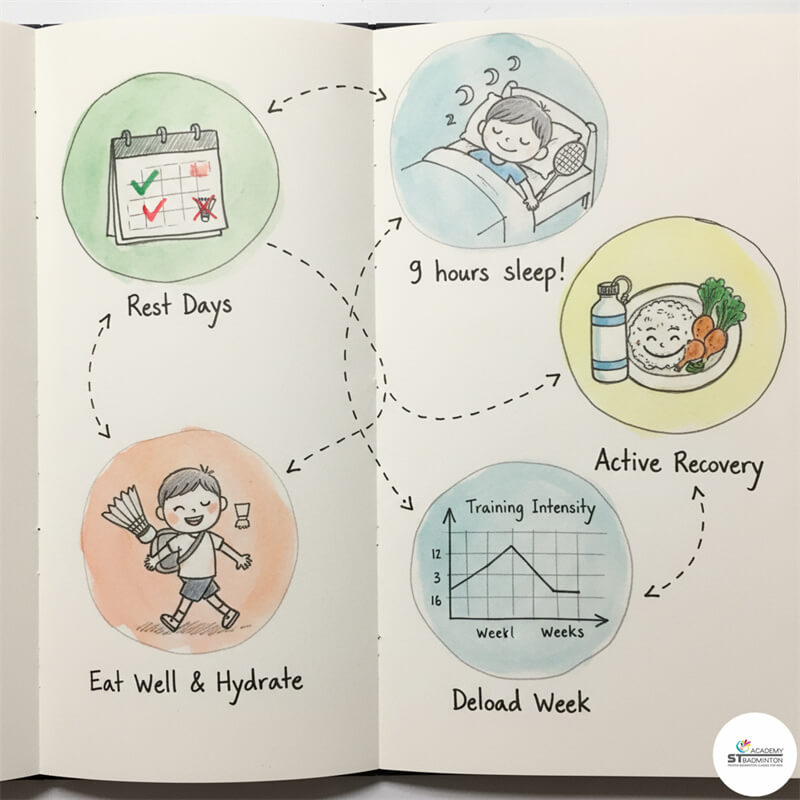
Core Strategies
Key Rest and Recovery Strategies for Badminton Players
Effective recovery for badminton players isn’t complicated. It’s about building simple, consistent habits into your weekly routine. Here are some of the most important badminton recovery tips that we teach our players, from young kids to competitive adults.
1. Planned Rest Days: Every player needs at least 1 to 2 days per week with no badminton training. This doesn’t mean lying on the sofa all day, but it means giving your body a break from high impact court movements. This is crucial for muscle recovery after badminton.
2. Badminton Sleep and Recovery: Sleep is the single most powerful recovery tool. Teenagers and serious young athletes often need 8 to 10 hours per night. Many players in Kuala Lumpur get far less due to school, homework, and late training sessions. A regular bedtime and reducing phone use an hour before sleep can make a huge difference.
3. Active Recovery: On a rest day, light activities like walking, gentle cycling, or stretching can help reduce muscle soreness by increasing blood flow, which is better than complete inactivity.
4. Nutrition and Hydration: You don’t need expensive supplements. Just focus on drinking enough water throughout the day and eating balanced meals with some protein (like chicken, fish, or tofu) after training to help muscle repair.
5. Deload Weeks: A smart training plan includes “deload” weeks every so often, where the intensity or volume of training is slightly reduced. This helps the body fully recover and adapt, leading to better long term progress.
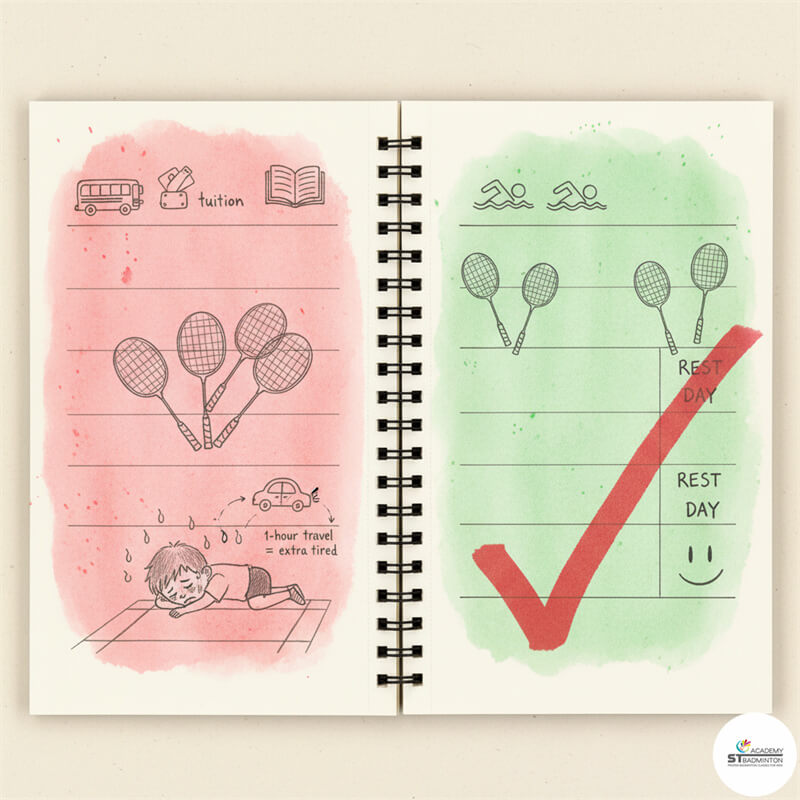
Smart Scheduling
Managing Training Load to Avoid Burnout in Badminton
As a coach, I often see parents who believe that more training sessions automatically lead to better results. This can be a dangerous mistake, especially with young players. A well balanced badminton schedule for kids in Malaysia is key to avoiding burnout and ensuring steady, long term improvement. Quality training combined with adequate rest will always be better than a high volume of tired training.
For most school age players, a healthy week might look something like this:
- 2 to 3 badminton training sessions (focused, quality sessions).
- 1 school PE class or other sport.
- 1 lighter activity day (e.g., swimming or cycling).
- 2 complete rest days.
Training every single day can easily lead to badminton overtraining and burnout. This is especially true for families in places like Air Panas, Selayang, or Kepong, where kids might spend an hour travelling to and from the court after a long school day. That travel time adds to their overall fatigue.
The message for parents is simple: resist the urge to pack the schedule. A child who is well rested and motivated for their three sessions a week will learn faster and be less prone to injury than a tired child who is being dragged to five or six sessions.
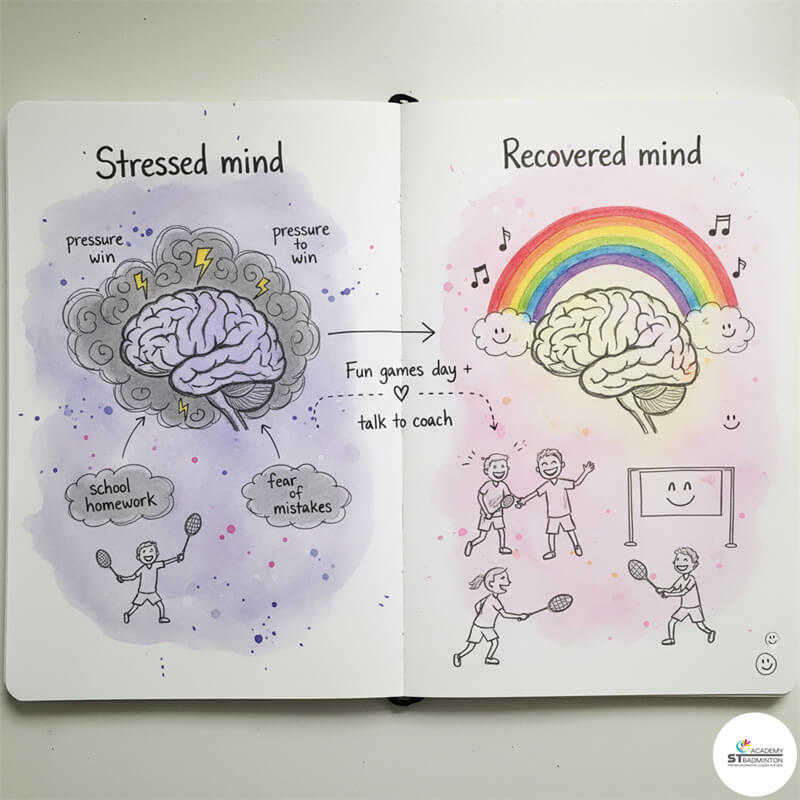
Mind & Motivation
Mental Recovery: The Other Half of the Game
Badminton burnout isn’t just a physical problem; it’s also mental. The constant pressure to win, balance training with schoolwork, and worries about performance can be mentally exhausting for young players. If a player is physically recovered but mentally tired, their performance on court will still suffer. Mental recovery is a crucial part of a complete badminton rest and recovery plan.
Mental fatigue can come from:
- Constant pressure to perform well in training and matches.
- A schedule so packed there is no time for fun with friends or other hobbies.
- Fear of making mistakes or losing a spot on the team.
Coaches and parents can help with simple mental recovery strategies. Sometimes, a training session should focus more on fun games rather than strict, repetitive drills. Having occasional “no competition” days where the focus is just on enjoying the game can relieve pressure. Most importantly, creating an environment where kids feel safe to talk about their stress from both school and badminton is key. A happy and mentally fresh player is always a better player.
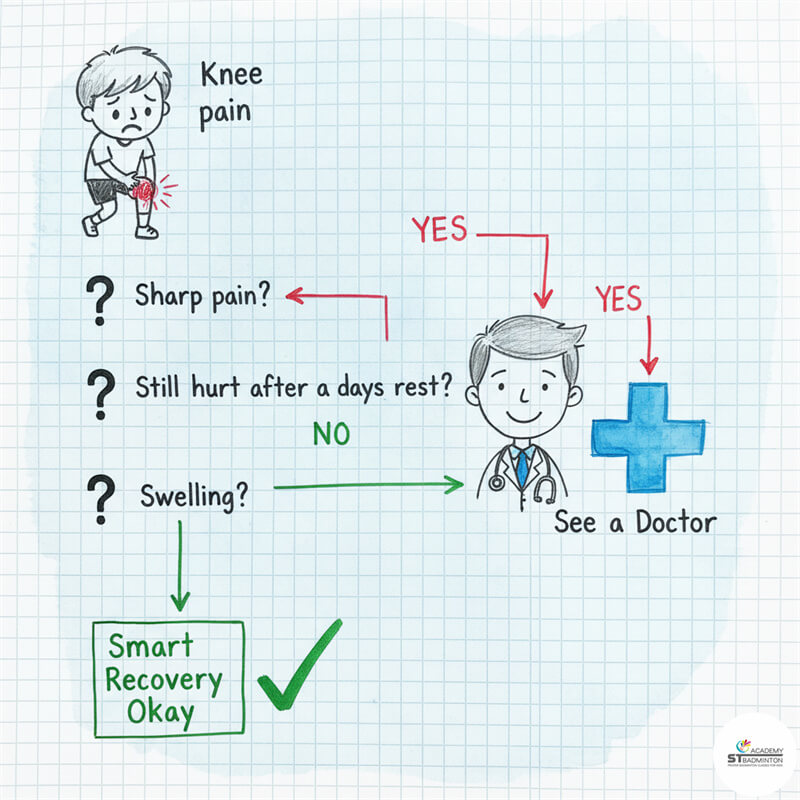
Important Note
When Coach Guidance Isn’t Enough: Seeing a Professional
This guide on badminton injury prevention and rest is for educational purposes, not medical advice. While a good coach can help you plan your training and recovery schedule, it is vital to know when an issue needs to be checked by a qualified healthcare professional. Pushing through certain types of pain can turn a small problem into a serious, long term injury.
You should see a doctor or a physiotherapist if you experience any of the following:
- Sharp, sudden pain during a movement.
- Pain that does not get better after a few days of rest.
- Noticeable swelling, bruising, or a feeling of instability in a joint.
- Pain that gets worse over time, even with less training.
As a coach, my role is to help players develop their skills and manage their training load safely. I can suggest recovery strategies and adjust training plans. However, diagnosing and treating injuries must be done by medical professionals. Never ignore persistent pain getting it checked early is the best way to ensure a quick and safe return to the court.
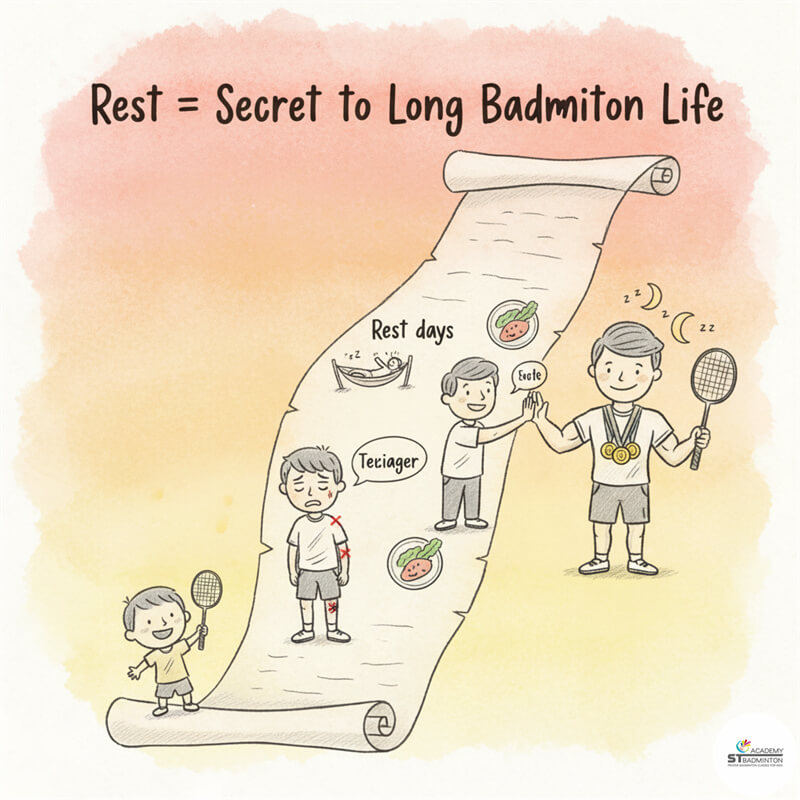
Final Thoughts
A Coach’s Final Advice on The Importance of Rest and Recovery in Badminton
In our culture, it is easy to think that “more is better.” Parents want the best for their children and players want to improve as fast as possible. But in sport, rest is not laziness it is a critical part of the training process. Building healthy badminton rest and recovery habits from a young age is one of the best ways to ensure a player can enjoy this fantastic sport for many years to come.
Whether you are a competitive player in Kuala Lumpur or a parent of a child just starting their badminton journey in Setapak or Cheras, remember to listen to your body. Celebrate the hard work on the court, but also value the quiet days of recovery that allow that hard work to translate into real, sustainable improvement. A smart player is a healthy player, and a healthy player is one who understands that recovery is just as important as training.
Frequently Asked Questions About Badminton Rest & Recovery
How many rest days a week should a young badminton player have?
For most young, developing players, having at least two rest days per week is ideal for proper badminton rest and recovery. This gives their bodies and minds a necessary break from the specific stresses of the sport. A rest day doesn’t mean they must be completely inactive. Light activities like walking, swimming, or casual cycling can act as “active recovery,” helping to reduce muscle soreness. The key is to avoid high impact, badminton specific movements to allow muscles, tendons, and joints to fully repair and adapt.
Can playing too much badminton cause burnout in kids?
Yes, absolutely. Overtraining in young badminton players is one of the main causes of burnout. This happens when a child trains too much without enough recovery time. Burnout isn’t just physical tiredness; it’s also mental exhaustion. A child might lose interest in the sport, feel constantly moody, or see their performance drop despite training more. It is crucial for parents and coaches to prioritise a balanced schedule and watch for these signs to avoid burnout in badminton and keep the sport enjoyable long term.
What is the difference between normal tiredness and overtraining?
Normal tiredness is feeling fatigued right after a good training session, but you feel refreshed and recovered after a night of sleep and a good meal. Overtraining, on the other hand, is a state of chronic fatigue where you feel tired all the time, even on rest days. Other signs of badminton overtraining and burnout include persistent muscle soreness, a drop in performance, frequent minor illnesses, trouble sleeping, and a lack of motivation to go for training. It’s a sign that your body isn’t getting enough time to recover.
How important is sleep for badminton recovery?
Sleep is the most critical tool for badminton sleep and recovery. During deep sleep, the body releases growth hormone, which is essential for repairing muscles and tissues that were stressed during training. For young and teenage athletes, getting 8 to 10 hours of quality sleep per night is vital for physical recovery, mental focus, and skill consolidation. A lack of sleep can lead to slower reaction times, poor decision making on court, and an increased risk of injury. It’s not an exaggeration to say that good sleep is as important as the training itself.
How can parents in Selayang, Kepong or Air Panas plan a balanced schedule?
For parents in areas like Selayang, Kepong, or Air Panas, travel time must be factored into the recovery equation. A balanced weekly schedule should include badminton training, schoolwork, other hobbies, and dedicated rest. Aim for 2 to 3 quality badminton sessions per week rather than 5 to 6 rushed ones. Schedule at least one full day off from all organised physical activities. Also, ensure there’s a buffer period between school, tuition, and training to allow the child to eat a proper meal and have a short mental break, helping to prevent burnout.
Can light stretching count as recovery for badminton players?
Yes, light stretching is an excellent form of active recovery for badminton players. After a tough match or training session, gentle stretching can help improve flexibility and relieve muscle tightness. On a rest day, it can promote blood flow to the muscles, which may help speed up the repair process and reduce soreness. However, it’s important not to be too aggressive. The goal is to gently lengthen the muscles, not to force a deep, intense stretch, which could cause more harm when your muscles are already tired and trying to heal.
Visual Guide to Rest & Recovery
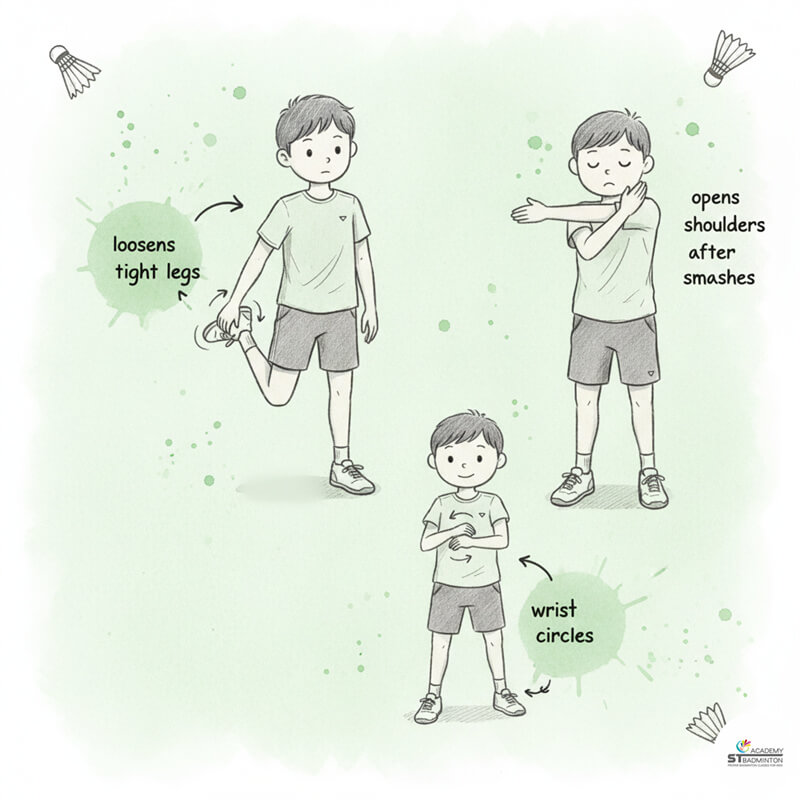
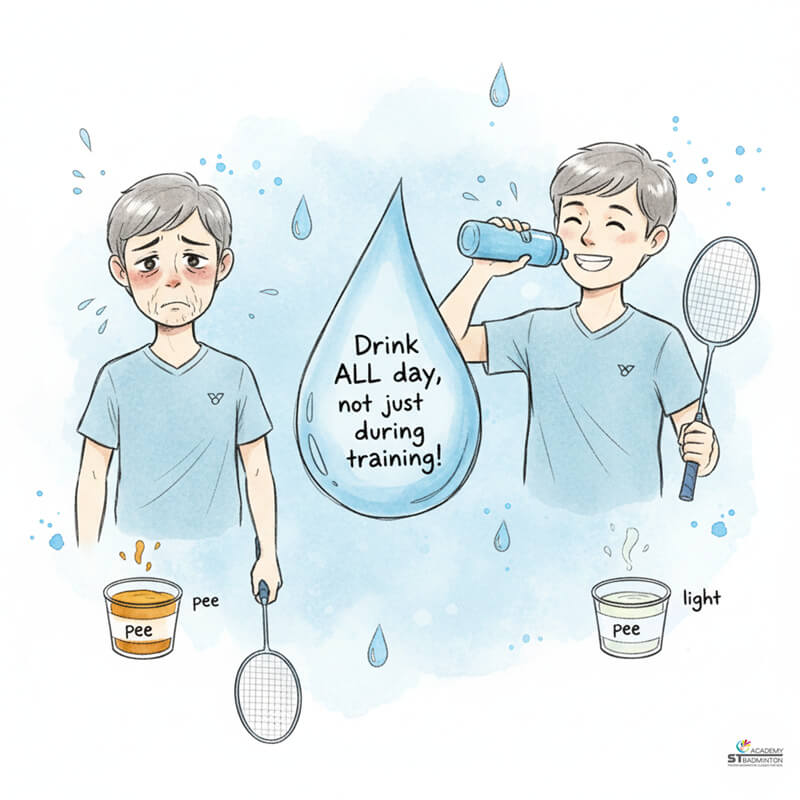
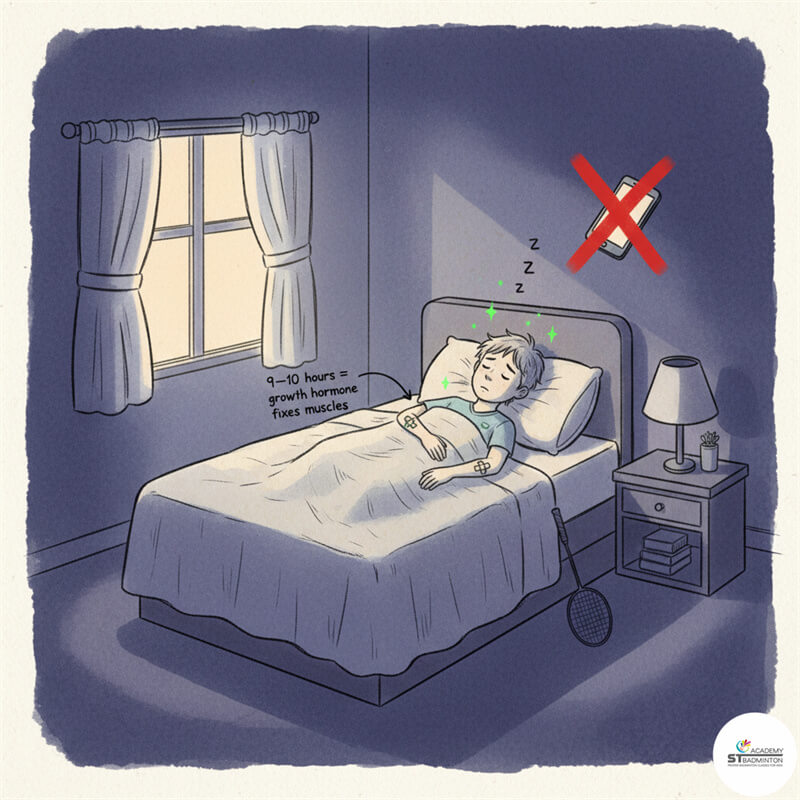
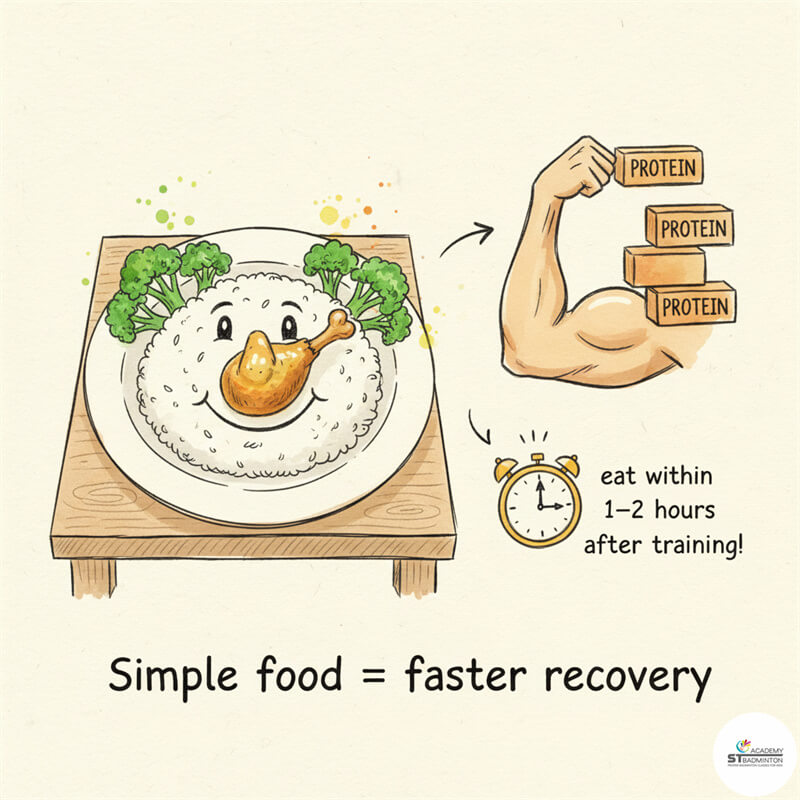
Building Stronger Players with Smart Rest and Recovery
A smart recovery plan does more than just prevent injuries. It builds resilience, improves on court focus, and ensures steady, long term progress. Our approach, refined over 15+ years, ensures that every player, from age 4 to competitive juniors, develops safe, effective habits for a lifelong love of badminton.
| Factor | Training-Only Mindset | Balanced Training & Recovery RECOMMENDED |
|---|---|---|
| Performance | Initial gains followed by a plateau or drop due to fatigue. | Steady, sustainable improvement as the body adapts and gets stronger. |
| Injury Risk | High risk of overuse injuries (e.g., shoulder, knee) from constant stress. | Lower risk as muscles and joints have time to repair and strengthen. |
| Motivation | Leads to physical and mental burnout, making training a chore. | Maintains love for the game and keeps players mentally fresh and eager to train. |
| Skill Development | Tired players develop bad habits and struggle to learn new skills. | A well-rested mind and body can absorb new techniques more effectively. |
| Long-Term Progress | Often results in players quitting the sport early due to injury or burnout. | Builds a healthy foundation for a long and enjoyable badminton journey. |
| For Young Players | Can create a negative relationship with sports and physical activity. | Teaches healthy lifestyle habits and promotes a positive athletic experience. |
Join a Balanced Badminton Training Program in Kuala Lumpur
Understanding rest and recovery is the foundation of smart coaching. At ST Badminton Academy Malaysia, we apply these principles daily in our training programs for kids (4+) and juniors. We focus on developing skilled players who are also healthy, resilient, and love the game. Our coach led environment teaches the importance of a balanced approach from day one. Contact us to learn more about our class times, fees, and how to start your child on a structured pathway that values recovery as much as repetition in Setapak, Wangsa Maju, Cheras and surrounding areas.

